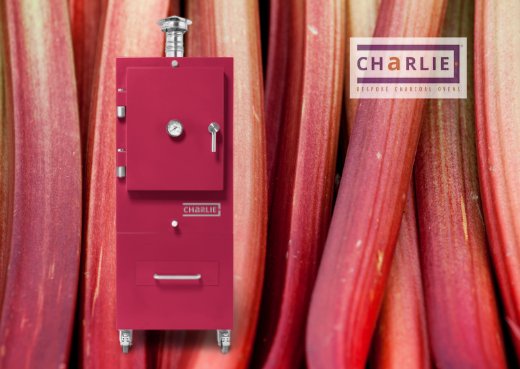Rhubarb is one of the first vegetables to come up in spring.
It’s also one of the most fabulous ingredients to cook with charcoal in the Charlie Oven. The combination of tartness and smokiness (usually allied to a dish with sweetness and/or fattiness) is simply deeeee-licious! Layered, complex, sophisticated.
So, what better time to introduce the new Rhubarb colour Charlie Oven? Which also happens to be the Pantone Colour of the Year. Beautiful.

Let’s talk rhubarb. That fabulous, but sometimes misunderstood ingredient.
Where does rhubarb come from?
The rhubarb plant can – probably, maybe - be traced back to China, Mongolia, or Siberia, with botanists divided on where it originally came from. It’s from the same botanical family as buckwheat, the Polygonaceae family. Strange as that may seem.
Here’s the surprise fact: even though it’s often classified as a fruit, botanically speaking, rhubarb is a VEGETABLE. So, sort of like tomatoes, but the other way round. If you get my drift.
How might a wine connoisseur describe the taste of rhubarb?
With a crunchy bite when raw, rhubarb tastes rather sour, although a better term to describe it would be “tart”. Its sour and tangy taste is a combination of citrusy-sweet-fruit-sourness of limes and lemons.
Its “puckery” taste resembles the effect on your tastebuds of green, unripe apples, prunes, and grapes. But this vegetable also packs a certain sweetness and fruity flavour - and sometimes even a bitter note, depending on the plant.
What are the types of rhubarb?
There are two main types:
What foods does rhubarb go well with?
Some people describe rhubarb's taste as savoury rather than sweet, which might be why it makes such a fabulous addition to so many desserts.
That contrast between sweet and savoury is often what makes the very best desserts.
But its tart, fruity flavour doesn’t just have to be paired with sweet ingredients. Rhubarb also - actually - goes brilliantly with things like lamb, pork and any fatty meat.
Read on below for one lovely sweet rhubarb recipe and one savoury one, both elevated to a different level by the alchemy of charcoal in the Charlie Oven.
Is rhubarb healthy?
Rhubarb a great source of both fibre and antioxidants. And it’s also low in calories and sugar.
It’s also high in calcium: one serving contains 15% of your RDA. Although the calcium in rhubarb isn't very easy to absorb.
Its trump health card might just be its antioxidant properties: its primary antioxidant is anthocyanin, which gives rhubarb its lovely pink colour. It's also associated with the reduction of inflammation.
Rhubarb Recipes:
1. Sweet: Rhubarb Crumble the Charlie Way:
Ingredients (serves four):
For the filling:
500g of rhubarb chopped into two-inch chunks
100g of light brown muscovado sugar
For the crumble topping:
150g of self-raising flour
120g of salted butter
60g of light brown muscovado sugar
50g of chopped hazelnuts and/or walnuts
25g of salted butter
Method:
Put 500g two-inch chunks of rhubarb into a saucepan with 100g of light brown muscovado sugar.
Cover and simmer on a very low heat for 15 mins. When soft, stir in the 25g of butter and pour the rhubarb into a medium-sized baking dish.
Heat the Charlie Oven and set it at 180°C.
To make the topping, rub 150g of self-raising flour and 120g of butter together with your fingers until you have a soft, crumbly topping.
Now add 60g of light brown muscovado sugar and 50g of chopped hazelnuts and/or walnuts. Mix it together with your fingers. Put the topping evenly over the rhubarb filling and tamp it down gently.
Just before you start cooking, add one large lump of charcoal onto the charcoal pile in the oven. Good quality, locally-produced lumpwood charcoal gives off its best aroma the moment it ignites. This is what will give you a little extra touch of magic in your crumble topping.
Now, put your crumble dish on a rack in the upper half of the Charlie Oven and bake for 30 minutes.
Serve hot with clotted cream or double cream.

2. Savoury: Chinese Pork Belly with Rhubarb and Ginger the Charlie Way:
Ingredients (serves 4)
800g of pork belly
1 teaspoon of Chinese five spice powder
300g of rhubarb, cut into one-inch chunks
1 tablespoon of honey
1 one-inch “thumb” of ginger, grated finely
1 tablespoon of light soya sauce
Zest and juice of one orange
Sea salt and freshly-ground black pepper
Method:
Heat the Charlie Oven and set it at 200°C. Close both the vents to just one-and-a-half inches open.
Put the pork belly onto a Charlie plancha, or a shallow baking tray. Rub the skin with a dry mix of the five spice powder and salt and pepper.
Place the plancha, or the baking tray on a rack, in the top half of the oven.
In another baking dish, mix the rhubarb with the ginger, soy sauce, orange and honey. Cover with foil.
When the pork has been in the oven for 15 minutes, add a small chunk of kiln-dried wood to the charcoal for extra smokiness. And then put the rhubarb dish on a rack in the top half of the oven.
After another 15 minutes, shut both vents completely and let the oven temperature drift very gradually down. Cook for another 45 minutes. By this point the Charlie oven will be at around 150°C-ish.
Let the pork belly rest under foil for ten minutes, then it’s ready to serve. Simply spoon the rhubarb mixture over the pork belly - and enjoy!



